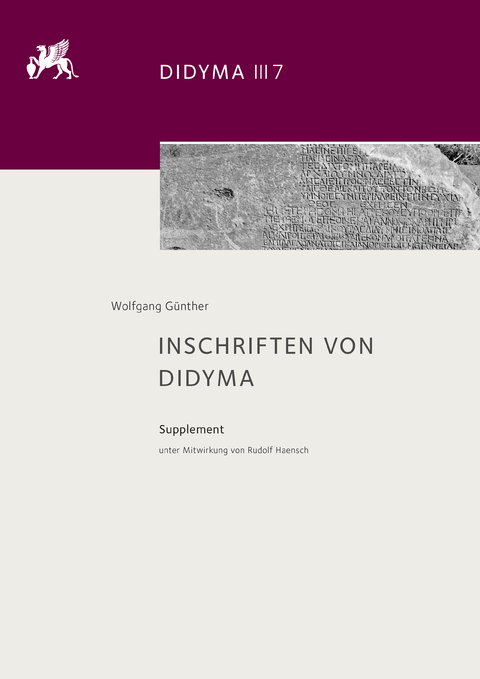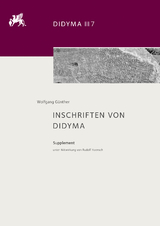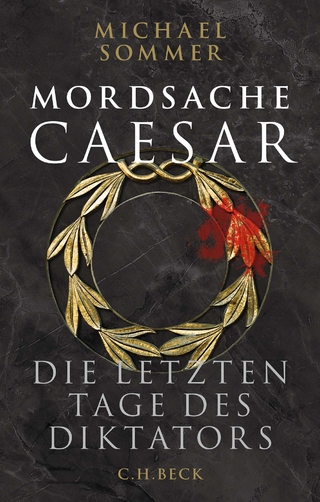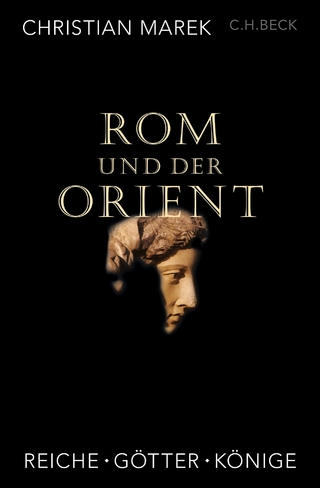Inschriften von Didyma
Supplement unter Mitwirkung von Rudolf Haensch
Seiten
2023
Reichert, L (Verlag)
978-3-7520-0723-7 (ISBN)
Reichert, L (Verlag)
978-3-7520-0723-7 (ISBN)
In diesem Band werden rund 300 Inschriften aus einem Zeitraum von einem Jahrtausend, vom 6. Jh. v. Chr. bis zum 6. Jh. n. Chr. vorgelegt. Sie dokumentieren die Geschichte des milesischen Orakelheiligtums, das nach dem Ende des paganen Kults in eine christliche Stätte umgewandelt wurde. Zahlreiche Zeugnisse spiegeln das gesamte Spektrum des Heiligtums wider: detaillierte Berichte über die Bauarbeiten am Apollontempel, Inventare als Verwaltungsdokumente, Weih- und Orakelinschriften als Zeugnisse der Religiosität und Selbstzeugnisse der repräsentativen Funktionsträger im Kult (Propheten und Hydrophoren) als Spiegel der milesischen Gesellschaft.
This volume presents some 300 inscriptions, some of which are inedita from the Prussian excavations carried out until 1925, but the vast majority of which are new finds from the excavation activities resumed since 1962. They essentially cover a period of one millennium, from the 6th century BC to the 6th century AD, interrupted by a gap of about 170 years that occurred after the destruction of the sanctuary in the Ionian Revolt of 494 BC until its renaissance in the period of Alexander the Great. The new material, which documents in particular the Hellenistic era and the Roman imperial period, is not only a quantitative but also a qualitative addition to the Didyma inscriptions already recorded in the corpus by Albert Rehm from 1958. For example, the building reports contain new, detailed information for architectural research about the status of work on the temple of Apollo in the early 2nd century BC; the oracle inscriptions provide information for religious history about the increasing tendency of the sanctuary to become a Pantheon and a home for other cults as well. Finally, the numerous monuments erected by the representatives of the Apollo and Artemis cults, the Prophets and Hydrophors, as self-testimonies, give a contoured picture of the Milesian elite and its network. At the end of the long tradition and the drying up of the epigraphic tradition, there is a legal document from the time of Iustinian, which in its unique preservation and visualisation of writing can virtually be considered the queen of late antique epigraphy. In diesem Band werden rund 300 Inschriften vorgelegt, die teils Inedita der bis 1925 durchgeführten preußischen Ausgrabungen, zum weitaus größeren Teil aber Neufunde der seit 1962 wiederaufgenommenen Grabungsaktivitäten sind. Sie umfassen im Wesentlichen einen Zeitraum von einem Jahrtausend, vom 6. Jh. v. Chr. bis zum 6. Jh. n. Chr. (unterbrochen durch eine Lücke von ca. 170 Jahren, die nach der Zerstörung des Heiligtums im Ionischen Aufstand 494 v. Chr. bis zu seiner Renaissance in der Alexanderzeit eintrat). Das neue, insbesondere die hellenistische Epoche und die römische Kaiserzeit dokumentierende Material ist nicht nur ein quantitativer, sondern auch qualitativer Zuwachs zu den bislang schon im Corpus von Albert Rehm (1958) erfassten Didyma-Inschriften. So enthalten die Bauberichte für die Bauforschung neue, detaillierte Informationen über den Stand der Arbeiten am Apollontempel im frühen 2. Jh. v. Chr.; die Orakelinschriften geben für die Religionsgeschichte Hinweise über die zunehmende Tendenz des Heiligtums, als Heimstätte auch anderer Kulte zu einem Pantheon zu werden. Die zahlreichen Denkmäler schließlich, welche die Repräsentanten des Apollon- und Artemiskults, die Propheten und Hydrophoren, als Selbstzeugnisse errichteten, zeichnen ein konturiertes Bild der milesischen Elite und ihrer Vernetzung. Am Ende der langen Tradition und dem Versiegen der epigraphischen Überlieferung steht eine Rechtsurkunde aus der Zeit Iustinians, die in ihrer einzigartigen Erhaltung und Schriftvisualisierung geradezu als Königin der spätantiken Epigraphik gelten kann.
This volume presents some 300 inscriptions, some of which are inedita from the Prussian excavations carried out until 1925, but the vast majority of which are new finds from the excavation activities resumed since 1962. They essentially cover a period of one millennium, from the 6th century BC to the 6th century AD, interrupted by a gap of about 170 years that occurred after the destruction of the sanctuary in the Ionian Revolt of 494 BC until its renaissance in the period of Alexander the Great. The new material, which documents in particular the Hellenistic era and the Roman imperial period, is not only a quantitative but also a qualitative addition to the Didyma inscriptions already recorded in the corpus by Albert Rehm from 1958. For example, the building reports contain new, detailed information for architectural research about the status of work on the temple of Apollo in the early 2nd century BC; the oracle inscriptions provide information for religious history about the increasing tendency of the sanctuary to become a Pantheon and a home for other cults as well. Finally, the numerous monuments erected by the representatives of the Apollo and Artemis cults, the Prophets and Hydrophors, as self-testimonies, give a contoured picture of the Milesian elite and its network. At the end of the long tradition and the drying up of the epigraphic tradition, there is a legal document from the time of Iustinian, which in its unique preservation and visualisation of writing can virtually be considered the queen of late antique epigraphy. In diesem Band werden rund 300 Inschriften vorgelegt, die teils Inedita der bis 1925 durchgeführten preußischen Ausgrabungen, zum weitaus größeren Teil aber Neufunde der seit 1962 wiederaufgenommenen Grabungsaktivitäten sind. Sie umfassen im Wesentlichen einen Zeitraum von einem Jahrtausend, vom 6. Jh. v. Chr. bis zum 6. Jh. n. Chr. (unterbrochen durch eine Lücke von ca. 170 Jahren, die nach der Zerstörung des Heiligtums im Ionischen Aufstand 494 v. Chr. bis zu seiner Renaissance in der Alexanderzeit eintrat). Das neue, insbesondere die hellenistische Epoche und die römische Kaiserzeit dokumentierende Material ist nicht nur ein quantitativer, sondern auch qualitativer Zuwachs zu den bislang schon im Corpus von Albert Rehm (1958) erfassten Didyma-Inschriften. So enthalten die Bauberichte für die Bauforschung neue, detaillierte Informationen über den Stand der Arbeiten am Apollontempel im frühen 2. Jh. v. Chr.; die Orakelinschriften geben für die Religionsgeschichte Hinweise über die zunehmende Tendenz des Heiligtums, als Heimstätte auch anderer Kulte zu einem Pantheon zu werden. Die zahlreichen Denkmäler schließlich, welche die Repräsentanten des Apollon- und Artemiskults, die Propheten und Hydrophoren, als Selbstzeugnisse errichteten, zeichnen ein konturiertes Bild der milesischen Elite und ihrer Vernetzung. Am Ende der langen Tradition und dem Versiegen der epigraphischen Überlieferung steht eine Rechtsurkunde aus der Zeit Iustinians, die in ihrer einzigartigen Erhaltung und Schriftvisualisierung geradezu als Königin der spätantiken Epigraphik gelten kann.
| Erscheinungsdatum | 12.12.2023 |
|---|---|
| Reihe/Serie | Didyma |
| Zusatzinfo | 44 Tafeln |
| Verlagsort | Wiesbaden |
| Sprache | deutsch |
| Maße | 210 x 297 mm |
| Gewicht | 1575 g |
| Themenwelt | Geisteswissenschaften ► Archäologie |
| Geschichte ► Allgemeine Geschichte ► Altertum / Antike | |
| Schlagworte | Altertumswissenschaften • Ancient Studies • archaeology • Archäologie • classical archaeology • Didyma • Hellenismus • Inschriften • Römisch |
| ISBN-10 | 3-7520-0723-0 / 3752007230 |
| ISBN-13 | 978-3-7520-0723-7 / 9783752007237 |
| Zustand | Neuware |
| Informationen gemäß Produktsicherheitsverordnung (GPSR) | |
| Haben Sie eine Frage zum Produkt? |
Mehr entdecken
aus dem Bereich
aus dem Bereich




